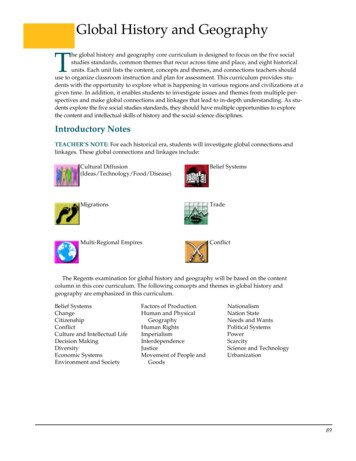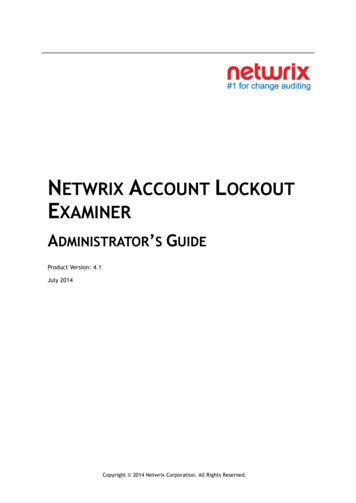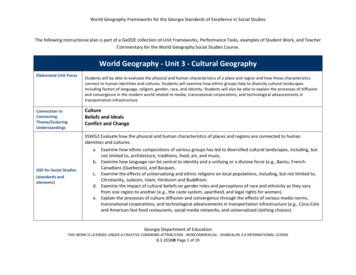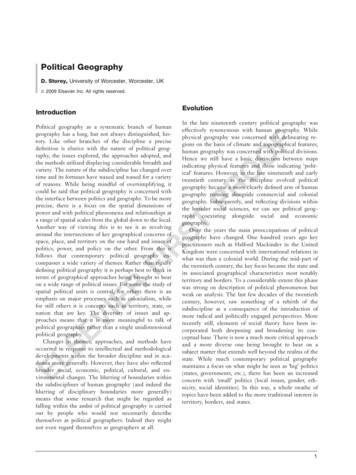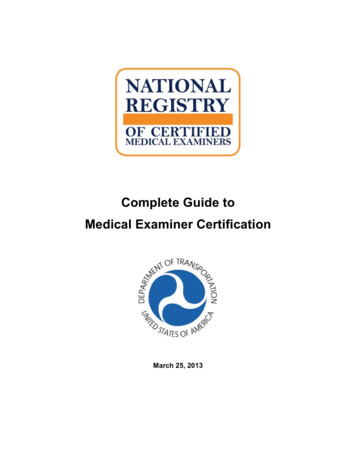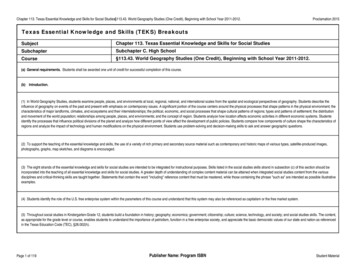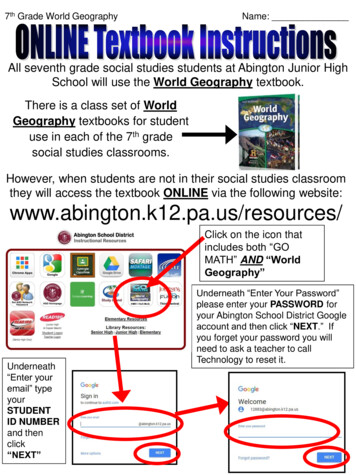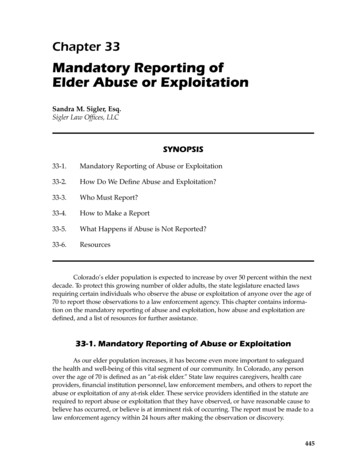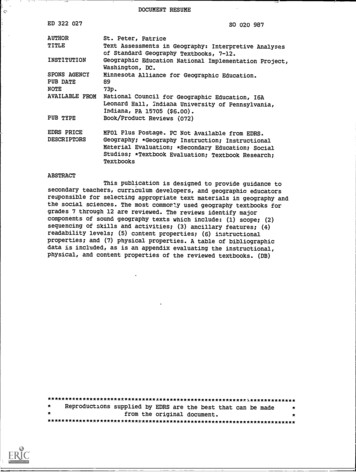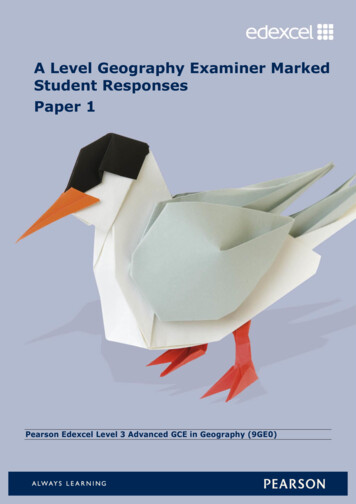
Transcription
A Level Geography Examiner MarkedStudent ResponsesPaper 1Pearson Edexcel Level 3 Advanced GCE in Geography (9GE0)
A Level Geography Examiner MarkedStudent ResponsesContentsIntroduction2Example 1 - Question 1 (b)3Example 2 - Question 2 (a)10Example 3 - Question 2 (b)15Example 4 - Question 2 (c)20Example 5 - Question 2 (d)24Example 6 - Question 3 (a) (i) and (ii)31Example 7 - Question 3 (b)Example 8 - Question 3 (c)3740
9GE0/01 Paper 1IntroductionThis guide has been created using student responses to our sampleassessment materials in A level Geography Paper 1 (9GEO/01). Theanswers and examiner commentaries in this guide can be used to showthe standards in the A level Geography assessment.Paper 1 assesses the physical geography topics in the A level Geographyspecification and is split into 3 sections:Section A: Students answer all question partsQuestion 1: Tectonic Processes and HazardsSection B: Students answer either Question 2 or Question 3Question 2: Glaciated Landscape and ChangeQuestion 3: Coastal Landscape and ChangeSection C: Students answer all question partsQuestion 4: The Water Cycle and Water Insecurity and The CarbonCycle and Energy SecurityThe exam duration is 2 hours and 15 minutes. The paper is marked out of105 marks and is worth 30% of the qualification.The exam paper will include open response, calculation and resourcelinked questions and calculators will be required. The marks per questionitem increase throughout each question so that each question willculminate with an extended open response question. Question 1 willculminate in a 12 mark extended open response question. Questions 2, 3and 4 will culminate in a 20 mark extended open response question.Our command words are defined in our specification, please see page 95,and will remain the same for the lifetime of the specification. Questionswill only ever use a single command word and command words are usedconsistently across question types and mark tariffs. Our AS and A levelGeography Getting Started Guide contains more information about thecommand words and mark tariffs used for different types of questions.2 Pearson Education Ltd 2017
9GE0/01 Paper 19GE0/01 Paper 1SECTION A: TECTONIC PROCESSES AND HAZARDSExample 1 – Question 1 (b)Mark scheme Pearson Education Ltd 20173
9GE0/01 Paper 14 Pearson Education Ltd 2017
9GE0/01 Paper 1 Pearson Education Ltd 20175
9GE0/01 Paper 1Student answers to 1 (b)Governance plays a very important role in successful management of megadisasters, for example if a very corrupt government is receiving aid andmoney from foreign countries to help those affected it is unlikely that theaid will reach the majority of those who need it. Also how organised thegovernment is plays a very big part as if the government hasn’t made stepsto modify loss, modify the event, or modifying resilience and vulnerabilityof the population then there will be bigger losses. An example of this isfound in the Tohuku tsunami and earthquake and the Haiti earthquake. Bothwere mega-disasters with 230,000 dying in the Haiti disaster and just12,000 dying in the Tohuku disaster despite it being a more serious andpowerful event. This difference in deaths was due to two governmentshaving different amounts of success in managing the disasters. TheJapanese government had evacuated its population, trained its army to dealwith this disaster, performed extensive risk assessments, and implementedplans in the event of a disaster. All of these management strategies weresuccessful and it was due to the governance. However in the Haitiearthquake very little was done by the government both in the preparationfor an event and to modify loss afterwards, this was mostly done by someNGOs afterwards. However it is possible that the different loses of the twoevents is due to their different levels of development as Japan can affordtechnology and other things in a disaster.In conclusion governance plays a very important role in successfulmanagement of tectonic mega-disasters. However it is not the only role asa country’s development is also another factor.Examiner s commentsThis response is awarded 9 marks.The candidate starts by making an unsubstantiated point on how poorgovernance (corruption) would not successfully manage tectonic megadisasters. Although the candidate is getting AO2 marks here it would havebeen better to use a named example – perhaps using the Izmit earthquake asa possible exemplar.The candidate then went on to explain how good governance throughpreparation and response limited the damage caused by the Japanese 2011tsunami resulting from the Tohoku earthquake compared to the Haiti 2010earthquake. The candidate did, however, evaluate the role of governance byexamining the role of different levels of economic development in causing thedifferences in the impacts between these two mega-disasters.6 Pearson Education Ltd 2017
9GE0/01 Paper 1This allows the candidate to access Level 3 as the answer shows some of theAO2 characteristics namely: Applies knowledge and understanding of geographical information/ideaslogically, making relevant connections/relationships. (AO2) Applies knowledge and understanding of geographical information/ideas tomake supported judgements about the significance of factors throughout theresponse, leading to a balanced and coherent argument. (AO2)The candidate could have developed their answer further into Level 3 byexamining the issues caused by long return intervals as well as short-termbudgetary constraints. This would have meant the candidate was secure inAO2 characteristic: Applies knowledge and understanding of geographical information/ideas toproduce a full and coherent interpretation that is relevant and supported byevidence. (AO2)A mega-disaster is where 2500 people were killed and the GDP of thatcountry was reduced by 5% for a year. Before a disaster occurs, earlywarning systems can be put in place to alert people before a disaster strikes.This allows people to escape safely via evacuation plan routes. Also thegovernment can invest in hazard proof infrastructure, which stops buildingfrom collapsing which reduces the impact of the disaster. Also they canallocate a budget for repair. This budget will cover most items in order toreturn to a good quality of life. Also people can insure possessions in casethey get broke or destroyed during a natural disaster. A stable governmentwill rebuild fast and recover fast but also build to a higher quality of lifethan before. However, an unstable government will take longer to rebuildbut also to a lower quality of life than before due to insufficient funding. Ifhighly invested in natural disaster strategies, it will reduce the overallimpact of the hazard. However if not prepared against, the hazard will havea greater effect. Often, if a hazard is left unprepared it will leave the countryin a state of total poverty.Examiner s commentsThis response is awarded 7 marks.The candidate discusses a variety in ways (which can be considered asexamples) in which the impacts of tectonic hazards can be reduced, but asthere are no named exemplars used these management strategies are rathergeneric to tectonic hazards and not to tectonic mega-disasters. They are alsonot clearly linked to governance. The candidate then assesses the need forgovernance by examining the likely impacts of not having any governance. Asa result it was thought that the candidate demonstrated Level 2 AO1 as theyshowed: Pearson Education Ltd 20177
9GE0/01 Paper 1 Demonstrates geographical knowledge and understanding, which ismostly relevant and may include some inaccuracies. (AO1)To obtain Level 3 the candidate could have used named examples to supportthe discussion of management strategies. The candidate could have also usedmega-disaster examples.The candidate also demonstrated Level 2 AO2 as the response showed: Applies knowledge and understanding of geographical information/ideaslogically, making some relevant connections/relationships. (AO2) Applies knowledge and understanding of geographical information/ideasto produce a partial but coherent interpretation that is mostly relevantand supported by evidence. (AO2) Applies knowledge and understanding of geographical information/ideasto make judgements about the significance of some factors, to producean argument that may be unbalanced or partially coherent. (AO2)To obtain a higher mark the candidate should ensure that the answer is focusedon what constitutes successful management and how governance plays a rolein it.Park's model is used to show the quality of life over time after a hazardevent takes place. The advantages of this are that the curves can be drawnon the same graph, as well as showing the development. However, thedisadvantages are that it is general and does not show the different levelsof development. Another way is to build the resilience a community has toa mega-disaster. This could be done by changing the way a building isconstructed to prevent it from falling. As well as making adaptations to acommunity to increase the resilience so that it is able to live in an activetectonic site. However increasing the resilience can also be hard to dobecause many disasters can be hard to predict and to reduce thevulnerability and increase the resilience, changes must be made before thedisaster take place.Also the amount of money that is put into the management can alsodetermine how successful it is. More money can be spent on managementin a MEDC, such as America and Japan, which means there will be a higherchance of the management being successful. This is the opposite to themoney spent on management in Asia and countries surrounding the IndianOcean. As well as there being no money to put into management in LEDCs,there may also be corruption in the government which stops the moneythat's meant to be spent on management being spent on something else.8 Pearson Education Ltd 2017
9GE0/01 Paper 1This therefore increases the vulnerability that that country has to thedisasters.Examiner s commentsThis response is awarded 4 marks.The candidate starts by evaluating the Parks model of how a country respondsto a tectonic event and so is not focused on the question. The candidate thenexamines whether the resilience of a community can be improved but lacksexemplars as well as a clear link to governance and mega-disasters. Thecandidate then examines the role of the level of economic development butagain is not focused on the key words of the essay - what constitutes successfulmanagement and how governance plays a role in it.It therefore demonstrates Level 1 AO1 namely: Demonstrates isolated elements of geographical knowledge andunderstanding, some of which may be inaccurate or irrelevant. (AO1)It therefore also demonstrates Level 1 AO2 namely: rmation/ideas, making limited logical connections/relationships.(AO2) Applies knowledge and understanding of geographical information/ideasto produce an interpretation with limited relevance and/or support.(AO2) Applies knowledge and understanding of geographical information/ideasto make unsupported or generic judgements about the significance offew factors, leading to an argument is unbalanced or lacks coherence.(AO2) Pearson Education Ltd 20179
9GE0/01 Paper 1SECTION B: LANDSCAPE SYSTEMS, PROCESSES ANDCHANGEExample 2 – Question 2 (a)10 Pearson Education Ltd 2017
9GE0/01 Paper 1Mark scheme Pearson Education Ltd 201711
9GE0/01 Paper 1Student answers to 2 (a)12 Pearson Education Ltd 2017
9GE0/01 Paper 1Examiner s commentsThis response is awarded 6 marks.The candidate starts by explaining the formation of a sandur. The candidateobtains AO1 marks by describing the braided river system but then obtainsAO2 marks by linking the meltwater to the sorted nature of the sandur.Similarly the candidate is obtaining AO1 by describing kettle holes and varvesand AO2 by linking the formation of these features with meltwater.The answer was therefore thought to be very secure in Level 3 as it showedthe attributes of a Level 3 answer namely: Demonstrates accurate and relevant geographical knowledge andunderstanding throughout. (AO1) Applies knowledge and understanding to geographical informationlogically to find fully relevant connections/relationships betweenstimulus material and the question. (AO2) Pearson Education Ltd 201713
9GE0/01 Paper 1Examiner s commentsThis response is awarded 6 marks.This answer was also thought to be secure in Level 3. The candidate explainsthe formation of a sorted outwash plain and so gains AO2 marks. The candidatealso explains how the gorge was formed due to increases in erosion alsogaining AO2 marks. Although there was some misunderstanding of kettleholes the answer was still thought to demonstrate most of the characteristicsof a Level 3 answer and so it was decided that this was worth Level 3 6 marks.This is an example of positive marking where even though one part of theanswer wasn’t fully correct, there was still enough AO2 material in the answerto obtain 6 marks.14 Pearson Education Ltd 2017
9GE0/01 Paper 1Examiner s commentsThis response is awarded 4 marks.Although the candidate has explained the formation of the sandur and soobtains AO1 marks. They have not however explained the likely stratificationthat would occur, which would have secured higher AO2 marks. In addition,the explanation of the pro-glacial lake is not explicitly linked to the diagram(where it has been created by a tongue of high land) and instead there is ‘textbook’ explanation. It is important to stress to students that Level 3 has to have‘fully relevant connections’ to the stimulus material. In this case it was thoughtthat the answer only showed ‘some relevant connections.This answer is thought therefore to be secure in Level 2. This is because itdisplays the characteristics of the Level 2 descriptors: Demonstrates geographical knowledge and understanding, which ismostly relevant and may include some inaccuracies. (AO1) Applies knowledge and understanding to geographical information tofind some relevant connections/relationships between stimulus materialand the question. (AO2)Example 3 – Question 2 (b) Pearson Education Ltd 201715
9GE0/01 Paper 1Mark scheme16 Pearson Education Ltd 2017
9GE0/01 Paper 1Student answers to 2 (b)Examiner s commentsThis response is awarded 6 marks.The candidate starts by describing the formation of terminal moraines and soobtains AO1 marks. The candidate then has descriptions (AO1 marks) andexplanations (AO2 marks) of how drumlins and recessional moraines can helpreconstruct ice movement, which are good as they clearly indicated how thedirection of ice movement is related to the characteristics of the features i.e.‘Therefore ice has moved up stoss ’.Although some of the explanations are not always accurate (there is someconfusion over terminal and push moraines), it was thought that this answerwas secure in Level 3 and was awarded 6 marks. This is because it displaysthe requirements of Level 3 which are: Demonstrates accurate and relevant geographical knowledge andunderstanding throughout. (AO1) Applies knowledge and understanding to geographical informationlogically to find fully relevant connections/relationships betweenstimulus material and the question. (AO2) Pearson Education Ltd 201717
9GE0/01 Paper 1Examiner s commentsThis response is awarded 3 marks.This answer starts correctly in partially explaining how the use of terminalmoraines can be used to reconstruct ice movement and so obtains AO2 marks.The candidate also describes the formation of kettle holes obtaining AO1 marksbut has only a partial explanation of how they can be used to reconstruct icemovement. The candidate is then diverted into explaining varves which is notcreditworthy.This answer was thought therefore to be Level 2 (3 marks) as it has some AO2marks. This is because it displays the characteristics of Level 2 namely: Demonstrates geographical knowledge and understanding, which ismostly relevant and may include some inaccuracies. (AO1) Applies knowledge and understanding to geographical information tofind some relevant connections/relationships between stimulus materialand the question. (AO2)18 Pearson Education Ltd 2017
9GE0/01 Paper 1Examiner s commentsThis response is awarded 2 marks.In contrast this candidate struggles to obtain AO2 marks. The candidateobtains AO1 marks by explaining the formation of recessional moraines, butas there was no explanation of how to date the moraines their response doesnot obtain AO2 marks. Although the candidate does obtain AO1 marks for thedescription of a drumlin they do not gain AO2 marks as their description is notlinked to reconstructing ice movement. Both of these elements of the answerare indicative of a key part of the Level 1 descriptor: Applies knowledge and understanding to geographical informationinconsistently.This answer was thought therefore to be top of Level 1 (2 marks). This isbecause it displays the characteristics of Level 1 namely: Demonstrates isolated or generic elements of geographical knowledgeand understanding, some of which may be inaccurate or irrelevant.(AO1) Applies knowledge and understanding to geographical informationinconsistently. Connections/relationships between stimulus material andthe question may be irrelevant. (AO2) Pearson Education Ltd 201719
9GE0/01 Paper 1Example 4 – Question 2 (c)Mark scheme20 Pearson Education Ltd 2017
9GE0/01 Paper 1Student answers to 2 (c) Pearson Education Ltd 201721
9GE0/01 Paper 1Examiner s commentsThis response is awarded 8 marks.The answer starts well by defining what the candidate understands to be aglacial system. This is a good approach to 8 mark knowledge andunderstanding questions as it focuses the remainder of the answer on glacialsystems as opposed to a description of the glacial mass balance. The studentalso clearly links the glacial mass balance to the glacial system. The studentthen clearly links the variations in a glacial balance to corresponding variationsin the glacial system.This was thought to be very secure in Level 3 and so was awarded 8 marks asit displays the characteristics of a Level 3 answer namely: Demonstrates accurate and relevant geographical knowledge andunderstanding throughout. (AO1) Understanding addresses a broad range of geographical ideas, which aredetailed and fully developed. (AO1)As with the exemplars for Q2a and Q2b it is important to remember thatalthough the response might also have included a consideration of temporalas well as altitudinal variations in the mass balance of a glacier, and how thismight aid our understanding of a glacial system, there was still enough AO1information in the answer to award Level 3 8 marks.22 Pearson Education Ltd 2017
9GE0/01 Paper 1Examiner s commentsThis response is awarded 5 marks.In contrast to the previous answer this candidate has focused on the conceptof mass balance and then implicitly linked it to the glacial system. Theirresponse could have been improved by explicitly linking the last sentence tohow variations in the mass balance aids our understanding of the glacialsystem.This was thought to be high Level 2 as it displayed the characteristics ofLevel 2 namely: Demonstrates geographical knowledge and understanding, which ismostly relevant and may include some inaccuracies.(AO1) Understanding addresses a range of geographical ideas, which are notfully detailed and/or developed. (AO1) Pearson Education Ltd 201723
9GE0/01 Paper 1Examiner s commentsThis response is awarded 2 marks.The candidate has not focused on the question as, unlike the other twoanswers, it has no links (explicitly or implicitly) to how the glacial mass balanceconcept contributes to an understanding of glacial systems. Instead theirresponse is an explanation of the mass balance of a glacier.This answer was therefore thought to be Level 1 (2 marks) as it displayed thecharacteristic of a Level 1 answer namely: Demonstrates isolated elements of geographical knowledge andunderstanding, some of which may be inaccurate or irrelevant. (AO1) Understanding addresses a narrow range of geographical ideas, whichlack detail. (AO1)Example 5 – Question 2 (d)Mark scheme24 Pearson Education Ltd 2017
9GE0/01 Paper 1 Pearson Education Ltd 201725
9GE0/01 Paper 126 Pearson Education Ltd 2017
9GE0/01 Paper 1Student answers to 2 (d)The candidate starts by defining periglacial landscapes and then assertsthat they are more sensitive to climate change. In this way the candidateis obtaining AO1 marks but could have developed their answer byindicating the likely effects of climate change on both periglacial andglacial relict and active landscapes, which would then become the focusof their answer as indicated in the indicative content in the mark schemeshown below:AO1Periglacial landscapes both active and relict are widelydistributed and include substantial areas of permafrostGlaciated landscapes both active and relict include both uplandand lowland landscapes formed by a variety of ice mass bothperiglacial and glaciated landscapes can occur as active andrelict environmentsClimate change will lead to increases in temperature andchanges in precipitation, which will impact on both the size andmovement of active glaciers and the occurrence of permafrost Pearson Education Ltd 201727
9GE0/01 Paper 1It is thought that this part of the answer would gain Level 2 AO1marks. This is because there is only limited AO1 detail which couldhave been improved through the use of place locations, predictedrises in temperature and rates of melting and predicted losses ofpermafrost areas. The answer therefore demonstrates Level 2 AO1criteria namely: Demonstrates geographical knowledge and understandingwhich is occasionally relevantThe answer is also obtaining Level 2 AO2 marks through explainingwhy periglacial landscapes are vulnerable to climate change, bylinking rising temperatures to increased melting and therefore thesubsequent absorption of more solar radiation, leading to furtherlosses. This means that the answer is thought to have demonstratedthe following AO2 characteristic: Applies knowledge and understanding of geographicalinformation/ideas with limited but logicalconnections/relationships. (AO2)The answer could have been improved by adding more AO1knowledge which would have allowed the candidate to access higherlevel AO2 marks as it would have allowed the answer to produce aninterpretation as well as allowing some on-going evaluation. Thiswould therefore meet the other two criteria of the level namely: Applies knowledge and understanding of geographical ideas inorder to produce a partial interpretation that is supported bysome evidence but has limited coherence. (AO2)and Applies knowledge and understanding of geographicalinformation/ideas to come to a conclusion, partiallysupported by an unbalanced argument with limitedcoherence. (AO2)28 Pearson Education Ltd 2017
9GE0/01 Paper 1The answer is then side tracked into explaining how the melting ofpermafrost areas might lead to further increases in temperature dueto the release of methane, a powerful greenhouse gas. Whilst thisis true it does not explain why periglacial areas are more or lessvulnerable to climate change than glaciated areas. Pearson Education Ltd 201729
9GE0/01 Paper 1It is thought that this part of the answer would also gain Level 2 AO1marks. As with the first part of the answer, there is only limited AO1detail. The answer could be improved through the use of widelyquoted information on glacial retreat in Alpine areas, as well as thepredicted temperature changes in high latitudes. The answertherefore demonstrates Level 2 AO1 marks as it: Demonstrates geographical knowledge and understandingwhich is occasionally relevantThere is a misunderstanding of the importance of the role of thealbedo effect in upland areas with regards to climate change. Theanswer suggests that there will be less ablation as there is a greatermass of ice reflecting the solar radiation back. Whilst this may be afactor in the predicted rate of retreat of some upland glacial areas,the impacts of changing temperatures and precipitation levels areexpected to play a far greater part in future changes in glaciatedareas than a consideration of the (lack of) change of the albedo insuch areas.There is a conclusion that is based on the evidence provided and sothe answer displays the characteristics of a Level 2 AO2 answernamely: Applies knowledge and understanding of geographicalinformation/ideas with limited but logicalconnections/relationships. (AO2) Applies knowledge and understanding of geographical ideas inorder to produce a partial interpretation that is supported bysome evidence but has limited coherence. (AO2) Applies knowledge and understanding of geographicalinformation/ideas to come to a conclusion, partially supportedby an unbalanced argument with limited coherence. (AO2)Examiner s summative commentsThis response is awarded 10 marks.The answer could have been improved by considering:Temporal considerations particularly shorter term change over time comparedto long term changes as all landscapes change over time withoutenvironmental change, simply through the long-term operation ofdenudational processes. The degree of change can therefore be related to thescale and pace of climate change.There are also spatial considerations as there are significant regional variationsthat will impact on these landscapes accordingly, with some of the mostsignificant impacts occurring in both Polar and Alpine environments. Mountainlandscapes are inherently more fragile than lowland landscapes simply throughgravity, so will be more sensitive to changes in climate than lowland regions.30 Pearson Education Ltd 2017
9GE0/01 Paper 1Example 6 – Question 3 (a) (i) & (ii) Pearson Education Ltd 201731
9GE0/01 Paper 1Mark scheme32 Pearson Education Ltd 2017
9GE0/01 Paper 1Student answers to 3 (a) (i)The cliffs at 3A are low lying and have a shallow gradient due to its lithology.It is made of soft clay. Clay is more susceptible to marine erosion than hardrock, therefore the cliff is more likely to collapse and recede due tocorrosion, corrasion, attrition, wave pounding and hydraulic action and sothe sea undercuts the cliff causing it to slump. Alternatively, clay is also lessresistant to weathering than hard rock, therefore the cliff is also attackedfrom the top by physical, biological and chemical weathering, and so furtherweakening the cliff system and causing the rock to be low and collapsing.Also the clay is easily susceptible to chemical weathering as it is morepermeable than hard rock, therefore absorbs water and chemicals and sobecomes denser, causing the cliff to slump under its own weight to formthe coast.Examiner s commentsThis response is awarded 4 marks.The candidate starts strongly with good use of terminology such as ‘lithology’as well the use of erosional processes such as corrosion and corrasion(abrasion) gaining the candidate AO1 marks. The candidate also recognizesthe importance of sub-aerial processes in the development of the cliff profileand explains a plausible weathering process.The candidate is obtaining AO2 marks for linking the rock type (clay) withresistance to erosion and subsequent collapse leading to the cliff profile shownin photograph 3A.The candidate, however, confuses the concepts of porosity and permeabilityand could have used the data on the resource (6m high cliff) as well asexplaining the role of mass movement processes that are clearly occurring onthis cliff face, which have an important influence on the cliff profile.As a result it though that the candidate demonstrated the attributes Level 2namely: Demonstrates geographical knowledge and understanding, which ismostly relevant and may include some inaccuracies. (AO1)Applies knowledge and understanding to geographical information tofind some relevant connections/relationships between stimulus materialand the question. (AO2)The cliff shown in figure A is made up of clay, a soft rock. This means thatthe cliff isn’t very high or very steep due to it being easily eroded. The beachbeneath the cliff is made up of boulders. There is evidence of slumping inthe figure as towards the base of the cliff the rock has started to move. Thisis due to both marine erosion and chemical weathering. Clay is a very Pearson Education Ltd 201733
9GE0/01 Paper 1permeable rock and will soak up water. When acid rain attacks the cliff, thewater will soften the rock causing it to slide downwards. The erosionprocesses of corrosion, corrasion, attrition, wave pounding and hydraulicaction will weaken the base of the cliff, causing higher rock to slump. Theboulders at the base of the cliff on the beach have been worn away andhave become smooth.Examiner s commentsThis response is awarded 3 marks.The candidate starts by identifying that the rock is clay and so ‘soft’ gainingAO1 marks. There is, however, less terminology than the previous candidate.The candidate also recognizes the importance of sub-aerial processes in thedevelopment of the cliff profile and explains a plausible mass movementprocess, but again lacks terminology expected at A level. This does howevergain AO2 marks as the candidate is linking the mass movement process(slumping) to the eventual cliff profile. There is then some use of terminologysuch as the use of erosional processes such as corrosion/corrasion also gainingAO1 marks.The candidate, however, also has a slight misunderstanding of the concept ofporosity and permeability and could have used the data on the resource (6mhigh cliff) as well as explaining the role of erosion in starting the cliff retreatprocess.The candidate demonstrates some attributes of Level 2 but is not as secure inAO2 as t
The exam paper will include open response, calculation and resource-linked questions and calculators will be required. The marks per question item increase throughout each question so that each question will culminate with an extended open response question. Question 1 will culminate in a 12 mark extended open response question. Questions 2, 3

